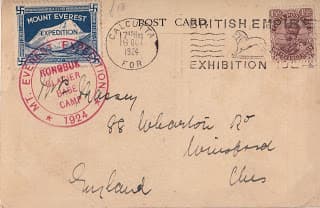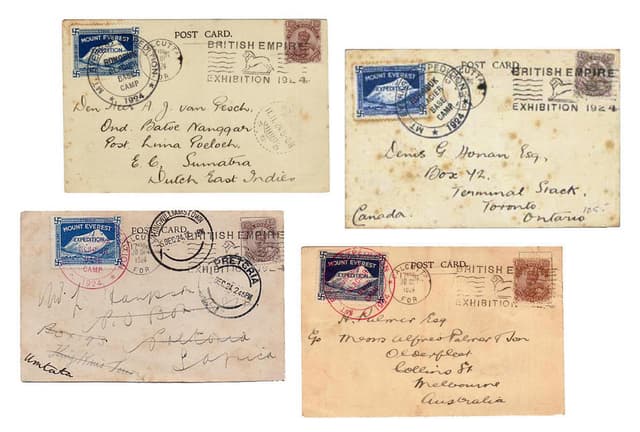A fundraising challenge to raise money for a legendary expedition
- Written by
- Aline Reed
- Added
- March 01, 2014

Whenever Aline is reading, which is as often as possible, she is also collecting. Any mention of fundraising is noted and, in this case, investigated. Wade Davis’s incredible book Into the Silence (about Mallory and his attempts to conquer Everest) included references to how the 1924 expedition was financed. Aline decided to find out more.
I confess: I covet this postcard. Apparently, it cost the princely sum of £18 when its lucky owner bought it recently. I want it for two reasons – it relates to a legendary expedition and it’s a wonderful fundraising curio.
Take a close look and, if you know anything about the exploration of Everest, a couple of details might leap out at you. First, the date: the Everest expedition of 1924 was the third attempt by British climbers to reach the summit of the world. The climb is the stuff of legend. George Mallory and Sandy Irvine died on the mountain, but an unanswered question has held a fascination for almost a century: did they reach the summit before falling to their deaths? Were Mallory and Irvine in fact the first to stand on the summit of Everest? Their success (or otherwise) continues to be the subject of debate and conjecture, which the discovery of Mallory’s body in 1999 further fuelled.
Second, you might notice whom the postcard comes from: John Noel, a member of the 1922 and 1924 Everest expeditions. Noel acted as photographer and film maker, and that’s where the fundraising comes in.
A fundraising challenge – could you raise money for a cause like this?

In 1924, The Everest Committee was strapped for cash. The previous two attempts to climb Everest had resulted in hefty bills. More money was lost when a bank failed and a clerk managed to embezzle £700 (a substantial sum of money at the time). Such financial mismanagement wouldn’t have inspired confidence in donors then, any more than it would do now.
There were other reasons to think twice before giving money to the Everest Committee – their disorganised approach to their finances also applied to their skill in putting together a mountaineering party. Two previous expeditions had failed and, this time, they’d decided to leave behind George Finch, who had climbed highest in 1922 and had pioneered the use of oxygen at altitude.
The 1922 expedition cost £12,548 and the Everest Committee looked incapable of raising a similar sum to finance another attempt in 1924. John Noel came came up with a solution.
 View original image
View original image
John Noel offered to raise £8,000 in exchange for retaining the photographic and film rights to the 1924 expedition. In addition, the Everest Committee would save a further £2,000 as it would no longer be obliged to cover the costs of John Noel’s work.
Noel took on a huge financial risk and it seems he took a number of approaches to fundraising. He set up a photographic and film company (Explorer Films) and sold shares at £1 each. He attracted investors and planned to recoup much of his investment from touring his film of the expedition. He had hoped The Epic of Everest would document the heroic tale of the first ascent of Everest. In the event, it witnessed the lead up to Mallory and Irvine’s tragic deaths.
But before those events transpired, Noel came up with a nice money-spinner.
Noel commissioned an artist to design a commemorative postcard and stamp (see above) for the 1924 expedition. Noel then placed an advertisement in the newspaper offering to send it to children in exchange for a small donation. Can you imagine the excitement? Receiving a postcard from Everest would be amazing now but back then the area had only recently been mapped.
Noel apparently employed two secretaries to deal with the responses to the newspaper advert, but by 10 am the next day they’d left – overwhelmed by the number of replies. Noel needed more help than he’d anticipated to arrange for the Indian postal service to deliver an estimated 40,000 postcards to children throughout the world. And he doesn’t forget to include a plug for his forthcoming film.
It’s interesting to note that the address on the back is hand-written, but the message on the front from John Noel is printed (but looks like it’s a personal message).
Information from: Into the Silence – the Great War, Mallory and the Conquest of Everest by Wade Davis and http://www.k2news.com/sn1.htm.
Postcard images from: http://ramblingsofadeltiologist.blogspot.co.uk/ and http://himalayana.com.

















